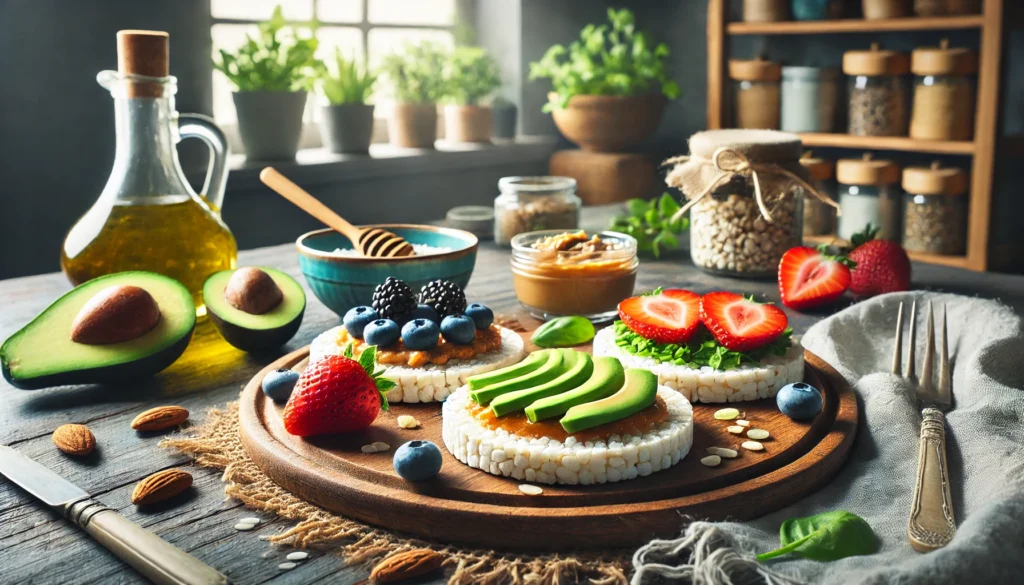Rice cakes can be a helpful snack for weight loss due to their low-calorie count, but their lack of protein and fiber may leave you hungry if eaten alone. To make them more satisfying, pair rice cakes with nutritious toppings like avocado, peanut butter, or hummus. Opt for plain or whole-grain varieties to avoid added sugars and unhealthy ingredients. While rice cakes can support a balanced diet, they should be part of a diverse, nutrient-rich eating plan for sustainable weight loss.

Rice cakes have long been a go-to snack for those looking to shed a few pounds, but are they truly a smart choice for weight loss? This crunchy, low-calorie treat might seem like a dieter’s dream, but let’s dig a little deeper to understand their impact on your health and weight-loss goals. By the end of this article, you’ll have a clear answer to whether rice cakes deserve a spot in your weight-loss journey.
Table of Contents
What Makes Rice Cakes Popular Among Dieters?
Rice cakes are light, crunchy, and easy to grab on the go. They’re often marketed as a healthy snack because they are low in calories and made from rice, a simple and familiar ingredient. Here’s why dieters tend to love them:
- Low-Calorie Count: A single plain rice cake typically contains around 35-40 calories, making it an appealing snack option for calorie counters.
- Portion Control: Their pre-portioned size helps prevent overeating.
- Versatility: Rice cakes can be paired with various toppings, from avocado to peanut butter, to suit different tastes and dietary needs.
- Gluten-Free: For those with gluten sensitivities, rice cakes are a naturally gluten-free option.
- Convenience: They are non-perishable and easy to store, making them a reliable snack to keep on hand.
The Nutritional Profile of Rice Cakes
While rice cakes may seem like the perfect weight-loss snack, it’s essential to examine their nutritional content to see if they align with your health goals. Here’s what you’ll typically find in a plain rice cake:
- Calories: ~35-40 per cake
- Carbohydrates: ~7-8 grams
- Protein: ~1 gram
- Fat: ~0 grams
- Fiber: ~0 grams
Although rice cakes are low in calories, they’re also low in essential nutrients like fiber, protein, and healthy fats. This means they won’t keep you full for long, potentially leading to more snacking later.
Are Rice Cakes Good for Weight Loss?
The answer depends on how and when you consume rice cakes. Let’s break it down:
Benefits for Weight Loss
- Low in Calories: If you’re in a calorie deficit—burning more calories than you consume—rice cakes can help you stay within your daily limit.
- Customizable: Adding nutrient-dense toppings like almond butter, cottage cheese, or hummus can make rice cakes more filling and nutritious.
- Quick and Convenient: Their portability makes them a handy option for busy individuals who need a quick snack.
- Allergen-Friendly: For people avoiding gluten or common allergens, plain rice cakes are a safe choice.
Drawbacks for Weight Loss
- Lack of Satiety: Rice cakes are not particularly filling on their own due to their low protein and fiber content. This could lead to overeating or frequent snacking.
- High Glycemic Index (GI): Rice cakes have a high GI, meaning they can cause a rapid spike in blood sugar levels. This may lead to energy crashes and increased hunger.
- Empty Calories: Without added nutrients, plain rice cakes provide little more than a temporary energy boost.
- Tendency to Overconsume: Because they’re so light, it’s easy to eat several rice cakes in one sitting, which can add up in calories without satisfying hunger.
How to Make Rice Cakes Work for Weight Loss
If you love rice cakes and want to include them in your diet, here are some tips to maximize their weight-loss potential:
1. Pair with Protein and Healthy Fats
Adding toppings like:
- Peanut butter or almond butter
- Sliced avocado
- Hummus and cucumber slices
- Smoked salmon and cream cheese
This combination balances the carbohydrate content of rice cakes with protein and fat, keeping you fuller for longer. A rice cake topped with hummus and turkey slices, for example, is much more satiating than a plain rice cake.
2. Use as a Meal Component
Instead of relying on rice cakes as a standalone snack, use them as a base for mini-meals. For example:
- Breakfast: Top with Greek yogurt and fresh berries for a protein-packed start to your day.
- Lunch: Spread with guacamole and add turkey slices for a balanced meal.
- Snack: Pair with a boiled egg for added protein.
- Dinner Side: Use rice cakes as a gluten-free alternative to bread for dipping into soups or stews.
3. Choose Whole-Grain Options
Some brands offer whole-grain rice cakes, which contain more fiber than their white rice counterparts. Fiber helps with digestion, promotes a feeling of fullness, and can aid in weight management. Check the labels to find these nutrient-rich options.
4. Limit Flavored Varieties
Flavored rice cakes often contain added sugars, artificial ingredients, or unhealthy oils. Stick to plain or lightly salted versions for a healthier choice. If you crave sweetness, add your own toppings like honey or sliced fruit.
5. Practice Mindful Eating
Eating rice cakes mindfully, savoring each bite, and avoiding distractions can help you feel satisfied with fewer calories.
Alternatives to Rice Cakes for Weight Loss
If rice cakes aren’t your thing or don’t keep you full, consider these alternatives:
- Vegetable Slices: Cucumbers, bell peppers, or zucchini slices are crunchy and low-calorie.
- Whole-Grain Crackers: These often have more fiber and nutrients than rice cakes.
- Air-Popped Popcorn: A low-calorie, high-fiber snack option that satisfies the craving for crunch.
- Rice Paper Wraps: Use them to make fresh veggie and protein rolls for a light meal.
- Sweet Potato Toasts: Thin slices of sweet potato baked or toasted make a nutrient-dense, gluten-free snack.
Common Myths About Rice Cakes and Weight Loss
Myth 1: Rice Cakes Are Always Healthy
Reality: While plain rice cakes are low in calories, flavored varieties can be loaded with sugar and additives, negating their health benefits.
Myth 2: Rice Cakes Help Burn Fat
Reality: No single food burns fat. Weight loss depends on a calorie deficit and a balanced diet.
Myth 3: Rice Cakes Are a Good Meal Replacement
Reality: Rice cakes lack essential nutrients and should not replace balanced meals. Use them as part of a well-rounded diet.
Final Thoughts
So, are rice cakes good for weight loss? They can be—but only if used strategically. While their low-calorie count makes them a tempting snack, pairing them with nutrient-rich toppings is essential to ensure they keep you satisfied and energized. If you enjoy rice cakes, think of them as a blank canvas for creating balanced, weight-loss-friendly snacks.
Remember, successful weight loss isn’t about a single food but about maintaining a healthy, sustainable eating pattern that works for you. Rice cakes can fit into that pattern—just make sure they’re part of a bigger picture focused on whole, nourishing foods.
By using rice cakes wisely and pairing them with high-quality ingredients, they can be a valuable tool in your weight-loss journey. So grab a rice cake, top it with your favorite healthy spread, and enjoy it as part of a balanced, mindful approach to eating!
Visit cake diary for more cake information.

